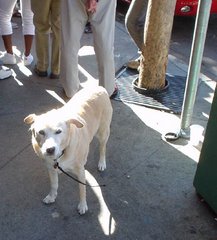For Rent: One Bedroom Birdhouse
August 2011
I love my local library. There is just so much information waiting to be taken home and loved, much like a puppy at the pet store just without all the bodily function surprises.
So! On such a trip while looking for info on gardening and patios, we ended up taking home a few books on building your own birdhouse. One was pretty straightforward, but the other was like Home For the Distinguishing Fowl. Some of them looked nicer than my house.
After an evening with David of planning ornate birdhouses, I did some actual research (I am finally learning - do all the research FIRST) and found out that hey, birds hate that. Here's the condensed skinny on getting a bird to actually live in something you make:
''Make it rough and look like a natural dwelling because bright colors aren't so good at hiding from predators that want to eat their babies, and birds won't live in it which kind of defeats the point''
So, sadness. We decided to dial down the birdy McMansion and make a birdy McHomeless shelter instead.
There is probably some lesson on humility and our materialistic society in here somewhere, but I am too busy picking out fabric for some new drapes to find it.
Step One:
Planning. Like, perhaps you should get the plans before you buy the wood, so your wife doesn't get all naggy and inform you that your wood is incorrectly sized and inferior.
Step 2:
Go back to Home We Own Your Soul Depot for more wood
Step 3:
Cut things. Preferably not your own limbs.
Step 4:
Put the pieces together to make sure they all fit

Step 5:
Come up with Ghettofied Version, since the original plans are not working out because someone bought lumber that was too thick. Ahem.
Step 6:
Re-cut select pieces
 The one feature worthy of the McMansion house - David cut these ledges into the front of the board leading to the entrance to make it easier for the babies to crawl out on their own for the first time
The one feature worthy of the McMansion house - David cut these ledges into the front of the board leading to the entrance to make it easier for the babies to crawl out on their own for the first timeStep 7:
Assemble. Buy a nail gun and just go crazy. That's what we did, anyway. And by we, I mean David because I am even more terrified of the nail gun than I am of the miter saw. Those things could misfire and shoot me in the eye, and then I would lurch blindly around the house, squeezing the trigger in agony AND THEN OH MY GOSH I SHOT MY DOG.
So.
I left it to David.
Step 7:
Get a bit of some kind for your drill that makes holes in wood and make an entrance in the door. Ours was 1 1/2 inches, which allow of many different types of birds. Be sure to check online or in a book to make sure what size your selected species of birds prefers.
 In retrospect, the best place to do this was probably not the kitchen floor.
In retrospect, the best place to do this was probably not the kitchen floor. Sometimes we get excited and things have to happen IMMEDIATELY.
We have no time for this 'proper planning' drivel
Step 8:
Nail down anything that is loose. Or, if you are Lily, attempt to defend against the nail gun and compressor with vicious barking and physical attacks. I don't think she liked the noise. I was sure she was going to get herself a nail through the lip, or even worse, make David shoot himself in the leg/arm.
Step 9:
Be proud of self and show off to everyone.
 Completed. The entrance is made double-thick as a deterrent to possible predators. I guess they see the deep hole and give up? Dunno, but any chance that I don't have to come out one day and see little dead baby birdies I will take.
Completed. The entrance is made double-thick as a deterrent to possible predators. I guess they see the deep hole and give up? Dunno, but any chance that I don't have to come out one day and see little dead baby birdies I will take.
























